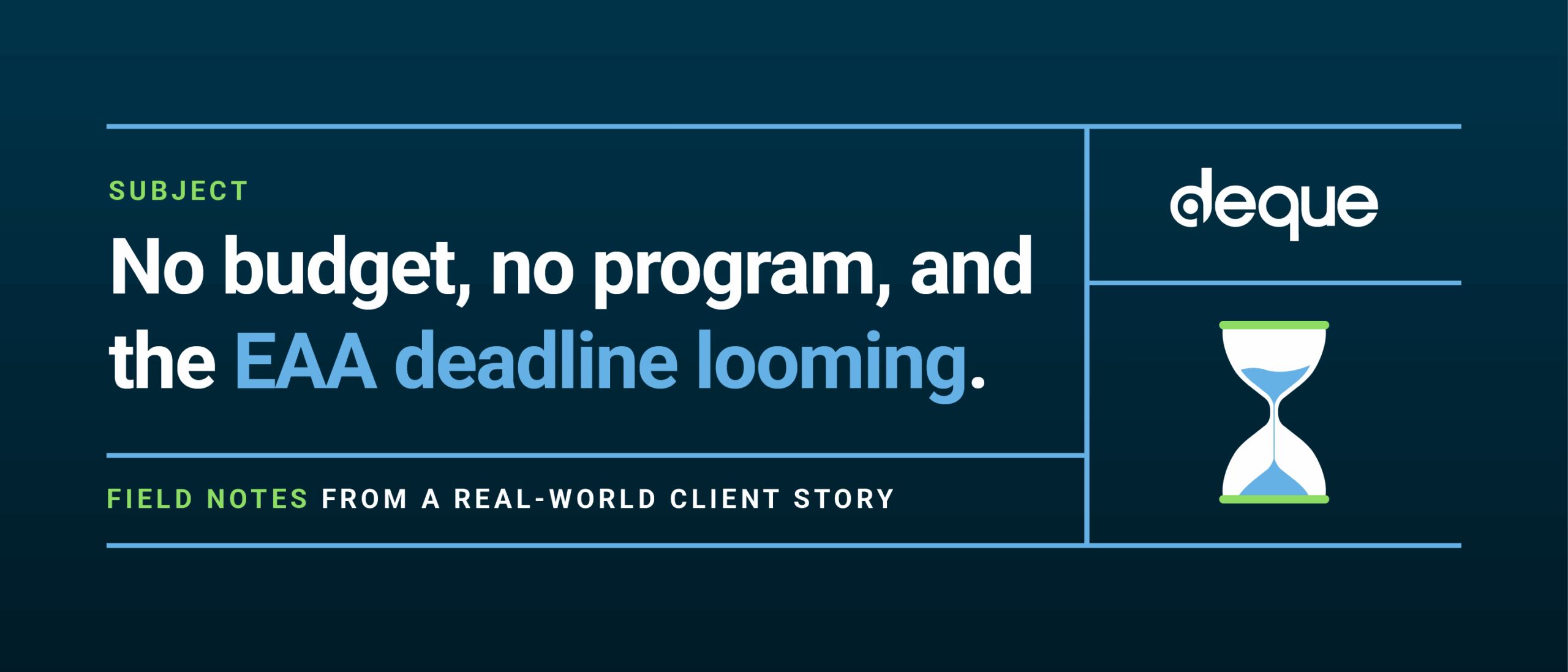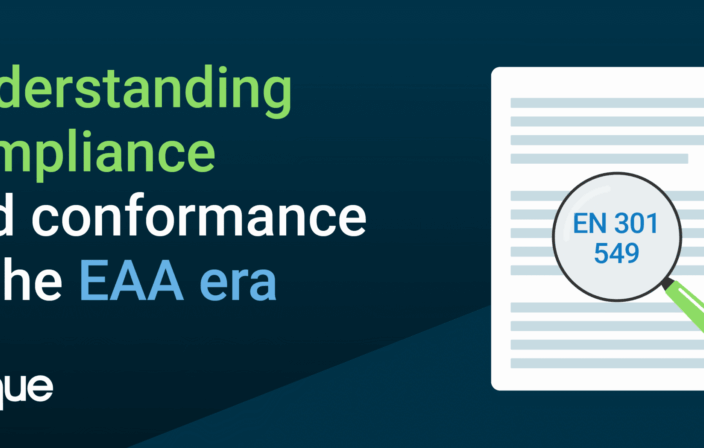Field notes from a real-world client story.
With this post, I’m embarking on a new series of articles focused on my client experiences in the field. I’m cheekily referring to the series as “Field Notes.”
As Senior Vice President and Chief Architect at Deque, I travel all over the globe, meeting with a wide array of organizations to discuss and implement digital accessibility transformation.
These articles give me an opportunity to share what I’m hearing about the actual challenges companies are facing and the practical steps they’re taking to elevate their digital accessibility programs to new heights.
While the stories I share will, of course, be anonymized, they’re nonetheless guaranteed to be chock full of real-world insights and ideas you can use to grow and optimize your accessibility program.
Let’s dig in!
The topic, the client, the challenge
Our topic today is preparation for the European Accessibility Act (EAA), and the client is a very large retailer with no accessibility program, and no planned budget. When they called us, it was urgent.
The company has a presence in multiple EU countries, operates both online and physical lines of business, and has more than 100,000 employees. Despite the scope of the challenge, however, the person tagged by leadership to organize the company’s EAA response has little to no experience with software or digital accessibility.
To the company’s credit, while they’re only just coming to understand their obligations under the EAA, they’re making an effort to tackle things head-on.
First steps: Mental preparation
You might think the first step in a situation like this would be tactical. But the reality is, you need to mentally prepare before you can strategically execute.
Digital transformation of any kind can be a massive and chaotic undertaking. Add in an impending deadline and the very real repercussions of failing to comply in time, and the stress levels go through the roof.
So, it’s essential that you give yourself some grace. You need to step outside of the maelstrom, assess things objectively, and remind yourself that this is difficult work. It’s going to take some time, and that’s okay.
It’s also critical to keep in mind that you did not create the current situation, nor are you being blamed for how things got to this point. The past is the past. What’s important is that you try to manage things on a forward-moving trajectory. Control what you can control, and be ready to pivot and adapt as new information or situations arise.
Finally, remember that the accessibility community is just that—a community. It’s full of talented, passionate, and experienced people who are more than happy to share their expertise and help when and how they can. Powerful tools, experienced practitioners, and valuable educational resources are readily available, and accessing them can help you accelerate your own efforts.
Next steps: Create the plan, sell the plan!
My next strategic recommendation to the client was to begin by taking immediate short-term action while concurrently building out a larger and more comprehensive long-term plan. After that, focus on getting leadership support for the plan. The goal is no surprises for anyone, even those only tangentially engaged with the effort.
Now, let’s look at some of the specific steps we discussed.
Gain legal alignment and support
It’s important to work directly with the team that covers legal, regulatory, and compliance matters. They are critical partners in this effort. Together, you need to understand how the EAA applies to your company and what kind of effort will be needed to be conformant. You also need to determine your approach to meeting the requirements. This could be anything from full-tilt focused auditing and remediation to taking a more risk-based approach to spot-fixing or triaging high-traffic and high-visibility user journeys and web pages. Finally, you’ll need to establish how you’re going to communicate information so that everyone is aligned and working towards a common goal.
Explore non-traditional funding approaches
No one likes to talk about money, but in business, it takes funds to make things happen. However, budget cycles being what they are, you may have to get creative if your deadlines are urgent and fall mid-cycle (the dreaded “unplanned spend”).
This was exactly the situation our client was facing.
The first thing I always make clear when it comes to budgets is that leadership has to fund digital accessibility. My recommendation is to request two to three strong internal resources to help build a scalable budget that articulates initial, intermediate, and long-term needs for training, tooling, and staffing. Leadership’s job is to reallocate the existing budget to make this happen and to secure adequate funding for the next fiscal cycle. Pro tip: Leverage your CFO. There are plenty of creative ways to find unplanned-for funds during any given fiscal year.
Reference GDPR to align leadership on creating a task force
When the situation is urgent, and deadlines are imminent, your best bet is to activate a task force and grant it “emergency powers.” This will simultaneously set the necessary “this is not a drill” tone and help you secure critical cross-functional resources from development, training, security, testing/QA, design, procurement, corporate communications, change management specialists, project management, human resources, executive leadership, and more. Did your company have a task force for GDPR? Use that experience as a reference.
Build accessibility awareness and implement a training plan
Raising awareness is an essential part of elevating digital accessibility. You can achieve this through everything from a keynote address to hands-on lab activities to presentations from employees with lived experience. You can follow up awareness campaigns with role-based training that includes digital accessibility fundamentals, learning modules on regulations and conformance, and how-to information on accessibility standards and success criteria. Every role in your organization should have some level of accessibility training within their learning and development plan.
Enable teams with tools
As soon as teams are trained and educated, you can equip them with the tools they need to ensure that what they’re building is accessible—from linters and AI-supported tools during the design and code creation process all the way through to manual testing with assistive technology. It is critical to activate these tools at just the right time. Introduce them too early, and adoption may be a struggle. Provide them too late, and you risk people forgetting what they learned during training.
Create a communication plan
The cardinal rule is that it is better to over-communicate rather than under-communicate. Share details and status reports as often as is realistic. Begin by letting the whole organization know that you’re actively developing a plan to create inclusive digital experiences that align with the new EAA regulations. When you create the task force, announce it and share details. As it becomes clear how different teams will contribute and be impacted, make sure this information gets disseminated. Share progress reports on a regular basis. The clearer and more consistent your communication, the more unified the effort will be. Clear communication also alleviates staff stress—people are happier when they know what’s going on.
Develop task force onboarding processes and materials
Make sure you have an onboarding process for new task force members. Over time, members will come and go. A documented onboarding process will help you ensure consistency as the effort evolves. Make sure this process includes materials on digital accessibility, the EAA regulation, strategic plans, operating models, and RACI charts. My favorite process is to stand up a simple SharePoint site with all the relevant materials, including a short video introducing people to the project.
Key considerations
As I mentioned earlier, you should have concurrent tasks at play. While implementing the other steps we’ve outlined above, you’ll also want to start creating a risk assessment for your legal or compliance team.
Risk analysis planning
In the case of our client, I recommended starting with a digital property inventory, then layering in usage and customer traffic data to help them understand which pages or user journeys were most critical to their organization.
After that, you can start adding in other key pieces of information, such as organizational alignment, product owner names, and whether accessibility efforts have begun on a given property or not. With EAA compliance as the focus, you might include which countries a digital property serves and which accessibility regulations apply.Pro tip: The list does not need to be perfect. Once you’ve identified one or two “Tier one” properties, you can proceed to another vital concurrent task: conformance testing.
Risk-based conformance testing
Timing your testing is an art. The sweet spot is to start testing so that the defects you identify can be routed to teams for remediation. You don’t want the data to age too long. Immediately after teams complete their training and are equipped with the appropriate tools, you can start sending them defects.
When it comes to testing and remediation, we recommend a three-phase approach:
- Automated testing. Use automated testing first. It is fast and cheap to complete. Then, remediate the defects found. After that, retest to confirm that you’ve truly cleared the issues.
- Semi-automated testing. Deploy semi-automated testing next. Deque’s Intelligent Guided Tests (available in the axe DevTools Extension) are an example of this. As you did with automated testing, remediate the defects you identify and then retest to confirm repair.
- Manual testing with assistive technology. Complete manual testing last. With this approach, you should have strong code that is stable. Manual testing is the most expensive and time-consuming type of testing. It also requires subject matter expertise. By doing this effort last, you’ll ensure that you are making the best investment of these resources.
Looking ahead
Deque excels at helping companies understand where they are and jointly building plans to rapidly grow and scale accessibility organizations. Despite the urgency of their situation and the inexperience of the individual tasked with leading the effort, our client is now well-positioned to get and stay EAA compliant.
How prepared is your organization? Let’s chat about how Deque can help you rapidly respond to regulations like the EAA. Schedule a free strategic consultation today.




